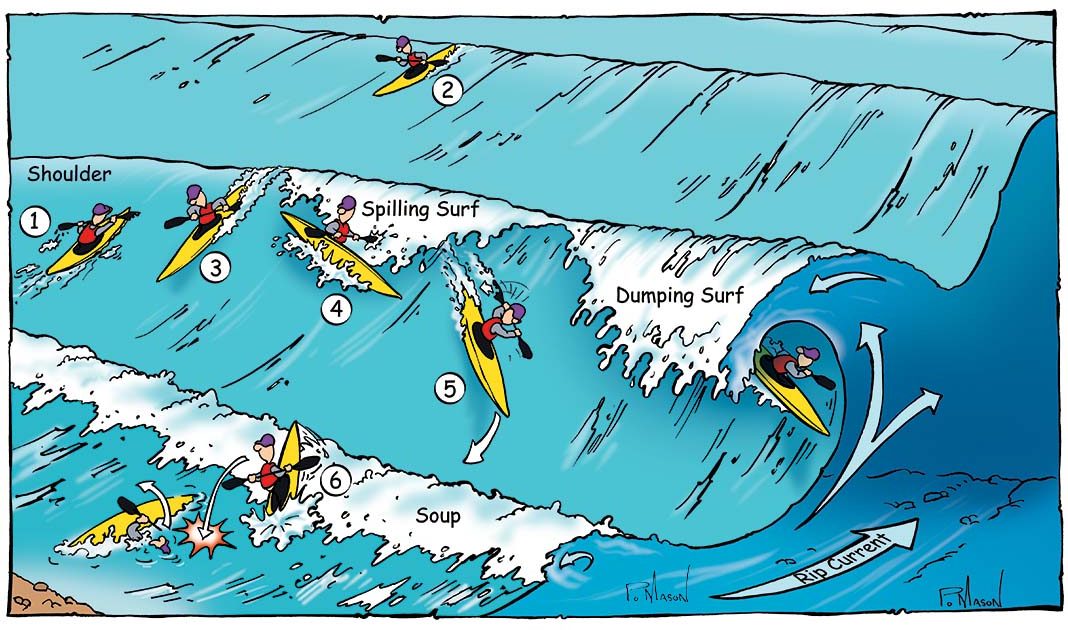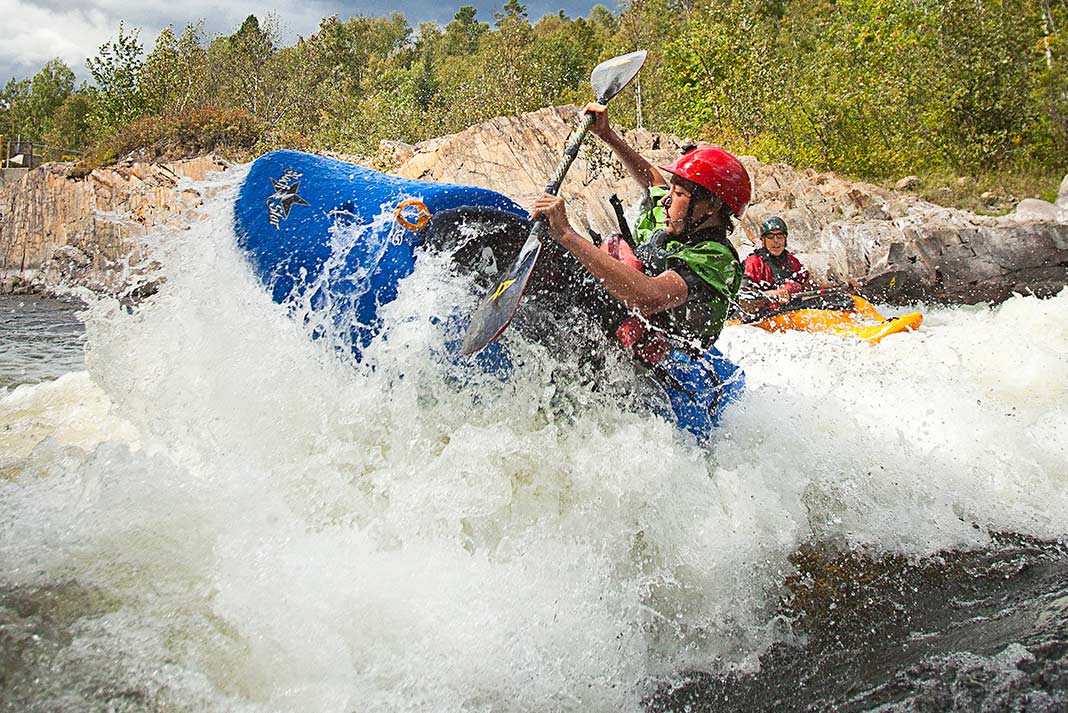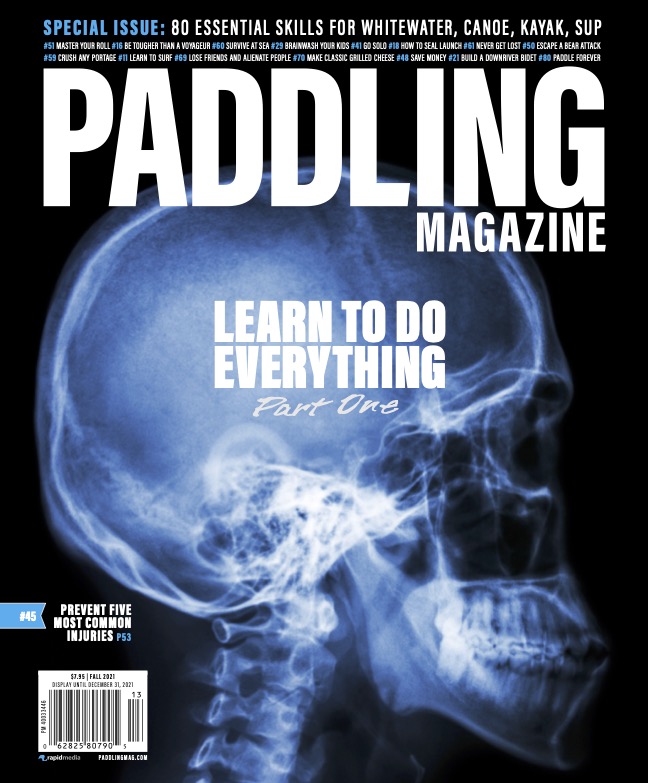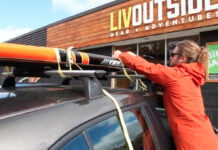Being able to kayak surf can change even the simplest of rivers into a new playground, even one that you may have run many times before. Front surfing is something that most paddlers can do quite quickly, thanks in large part to great boat designs. In particular, short boat lengths and considerable rocker let you surf on any part of all but the steepest waves without having to worry about your upstream end pearling. But the design characteristics of your boat will only get you so far. Then you need to develop sound surfing skills that allow you take advantage of the steeper and trickier waves.
Learn the basics of surf kayaking
First of all, most of your surf time should be spent on the face of a wave—where you can move about and set up other play moves. On mellow waves, you can often surf on the face without any effort whatsoever. In these cases, all you need to do is maintain control of your boat with rudders. On steeper, or breaking waves, you need to get more aggressive with your surfing in order to stay on the face. This involves carving back and forth from one ferry angle to the next. The steeper the wave is, the more aggressively you have to carve.
When it comes to learning how to kayak surf, the first step is learning the terminology. From there we’ll move onto the skills you’ll need to work on.

Anatomy of the surf zone
Shoulder
The edges of a breaking wave will often stay green and glassy longer than the top-heavy middle section, making longer, smoother rides possible.
Spilling surf
The safest place to learn to surf is off of a gently sloping beach where the swells release their energy gradually.
Dumping surf
Swells break explosively at the edge of a sharp drop-off like a shoal or a steep beach, or at a river mouth. Dumping surf offers the potential for tube rides, but it’s also the most challenging.
Soup
A quiet field of foamy water forms at the end of the surf zone.
Rip current
Wave energy can reflect off of the beach and create a strong offshore current, which can be used to your advantage when launching but creates a hazard for swimmers. To escape a rip current, swim perpendicular to the current to reach waves that will wash you ashore.
Breaking down positioning
Body position
First and foremost, you need to keep your weight centred as much as possible when you’re surfing. Sitting upright puts you in the most stable position and affords you the most control over your boat. This doesn’t mean you can’t lean back if you need to. Feel free to be active with your forward and backward leans. Just return to a centred body position as quickly as possible.
Paddle position
Your paddle should be acting as a rudder at all possible times, because it’s the steering wheel for your kayak. You’ll use it to hold your ferry angle as you carve across the face of the wave and then you’ll pry with it to cut back and ferry in the other direction.
The ideal rudder gets planted with your paddle parallel to your kayak, and with your elbows down and your front hand held between shoulder and eye level. Keeping this front hand high buries your active blade deeply in the water. Having your paddle parallel to the kayak ensures that your rudder is not acting as a brake pulling you off the wave. Your upper body should also be rotated to face your paddle when it’s in this position, because it gives your rudder the most power and helps keep your shoulders safe.
Boat position
Your boat will be in one of two positions when front surfing. It will either face directly upstream, or it will be on a ferry angle to one side or the other. When pointed to 12 o’clock, your kayak will want to shoot down into the trough of a wave, so unless you’re on a fairly flat wave, you’re going to want to be alternating from one ferry angle to the other.

Essential surf zone skills
1 Paddling out
You don’t have the option of duck-diving in a kayak, so choose your exit route carefully. Scout the beach beforehand, looking for deep-water channels where breaking waves are less common. If you must punch through a breaking wave, paddle like hell, knife your paddle through the wave and reach for the green water on the other side. Keep your deck free of gear.
2 Catching a wave
Position yourself beyond the line of breakers. Faster boats such as sea kayaks can catch non-breaking swells offshore or on the shoulder of the surf zone—far less intimidating places to start out. Look over your shoulder as you paddle with the waves. When you see a wave you want to catch, sit upright and paddle forward aggressively with powerful, rapid-fire strokes as the wave lifts your stern. If your timing is right, your kayak will accelerate as it slides down the face of the wave. If you don’t quite have the speed, you might find yourself perched on the crest. Throw your weight forward and be prepared for a thrilling ride.
3 Riding the face
As you rocket down the wave’s face, lean back slightly and perform a stern rudder with your paddle to slow down and wait for the crest of the wave to catch up. Shorter, more rockered sea kayaks and surf kayaks can carve turns on the face of a wave just like board surfers. Steer with your hips and your paddle: Edge your boat into the wave while performing a stern rudder on the down-wave (opposite) side.
Shorter, more rockered sea kayaks and surf kayaks can carve turns on the face of a wave just like board surfers. When it comes to edging your kayak, most paddlers’ instincts tell them they should tilt their boats into each turn when they plant their rudders. On flatter, smooth waves this works quite well, and you can carve some great turns like this, just like board surfers. However, on steeper waves that are breaking, it is more important to keep your kayak tilted downstream to prevent your upstream edge from getting caught. In these cases you’ll hold a downstream tilt on your boat as you pry your bow around from one ferry angle to the next. As your boat passes 12 o’clock, you’ll need to tilt your boat onto its other edge and switch the side on which you’re ruddering.
4 Broaching and side-surfing
Broaching occurs when your kayak’s bow digs into the trough and gets the stern pushed broadside by the wave’s breaking crest. The longer the kayak, the more prone it is to broaching. If you catch it early, it’s possible to avoid a broach by leaning back to unbury the bow and aggressively edging and ruddering with your paddle blade to carve back on course. Failing that, lean hard into the wave, tuck your elbows in close to your ribcage and side-surf with your paddle braced into the foam pile, using a low brace or high brace depending on wave height.
5 Spins
To spin out of a broach, tilt into the wave and turn your brace into a forward sweep. Don’t expect to spin more than 90 degrees in a sea kayak, just enough to regain your front surf; you may need to coax your boat into the spin by leaning back to free the bow. Flat-hulled whitewater and surf kayaks spin more easily—even on the green face of a wave. Alternate between forward and reverse sweeps, remembering to shift your weight from edge to edge, keeping the boat tilted into the wave.
6 Loops
Big, steep waves can toss sea kayaks end over end. To perform a loop, sit perpendicular on the crest of a wave and throw your weight forward, burying the bow in the trough. If the wave is big enough, your stern will be thrown skyward, leaving you standing on the foot pegs, well above the whitewater. From here, it’s possible to pirouette by planting a sweep stroke in the wave crest; otherwise, get ready for a high-speed crash landing. Hold your breath, wait for the wave to pass, and roll up.
This article originally appeared in Paddling Magazine Issue 65. Subscribe to Paddling Magazine’s print and digital editions here, or download the Paddling Magazine app and browse the digital archives here.
Learn how to surf kayak and you can really catch a wave. | Feature photo: Image Ontario









You should really include some info on surf etiquette, or at least a link to that. Important for new surfers to know.
Sorely lacking from this article is a discussion of surf etiquette and the rules of the road. Also, it’s important to know how to interact with surfers.
Some aspects you have not considered:
When getting on the wave are there others there already or not aware of you? A kayak is heavy and can hurt a surf board rider/body border/swimmer
When coming in on the soup are there kids in the sea (this is where they tend to be). If yes you need to get out of the way as the kayak will hurt kids playing in the soup
If you bale out hold onto your kit. Plastic kayaks running into the beach will hurt those in the way.
As a waveski user I see these issues continually and it is this consideration that seems to be missing. Think of others.